RBSE Solutions for Class 9 Maths Chapter 14 Statistics Ex 14.3
Rajasthan Board RBSE Solutions for Class 9 Maths Chapter 14 Statistics Ex 14.3 Textbook Exercise Questions and Answers.
Rajasthan Board RBSE Solutions for Class 9 Maths in Hindi Medium & English Medium are part of RBSE Solutions for Class 9. Students can also read RBSE Class 9 Maths Important Questions for exam preparation. Students can also go through RBSE Class 9 Maths Notes to understand and remember the concepts easily. Practicing the class 9 math chapter 13 hindi medium textbook questions will help students analyse their level of preparation.
RBSE Class 9 Maths Solutions Chapter 14 Statistics Exercise 14.3
Question 1.
A survey conducted by an organisation for the cause of illness and death among the women between the ages 15-44 (in years) worldwide, found the following figures (in %)
|
Causes |
Female fatality rate irc) |
|
1. Reproductive health conditions |
31.8 |
|
2. Neuropsychiatric conditions |
25.4 |
|
3. Injuries |
12.4 |
|
4. Cardiovascular conditions |
4.3 |
|
5. Respiratory conditions |
4.1 |
|
6. Other causes |
22.0 |
(i) Represent the information given above graphically.
(ii) Which condition is the major cause of women’s ill health and death worldwide?
(iii) Try to find out, with the help of your teacher, any two factors which play a major role in the cause in (ii) above being the major cause.

Answer:
(i) The required graph (a bar graph) is as above:
In the graph drawn, causes of illness and death among women between the ages 15-44 (in years) worldwide is denoted along the X-axis and female fatality rate (%) is denoted along the Y-axis.
(ii) The major cause of women’s ill health and death worldwide is reproductive health conditions.
(iii) Two factors which play a major role in the cause in (ii) above are lack of education and non-availability of good health centres.

Question 2.
The following data on the number of girls (to the nearest ten) per thousand boys in different sections of the Indian society is given below:
|
Section |
Number of girls per thousand boys |
|
Scheduled Caste (SC) |
940 |
|
Scheduled Tribe (ST) |
970 |
|
Non SC/ST |
920 |
|
Backward districts |
950 |
|
Non-backward districts |
920 |
|
Rural |
930 |
|
Urban |
910 |
(i) Represent the information above by a bar graph.
(ii) In the cassroom discuss what conclusions can be arrived at from the graph.
Answer:
(i) The required graph is as below:
In the graph drawn, different sections of the society are denoted along the horizontal axis and the number of girls to the nearest ten per thousand boys are denoted along the vertical axis. Their intersection represents 900. Scale: 1 cm = 10 girls.
(ii) From the graph, we find that the number of girls to the nearest ten per thousand boys are maximum in scheduled tribes, whereas they are minimum in urban.
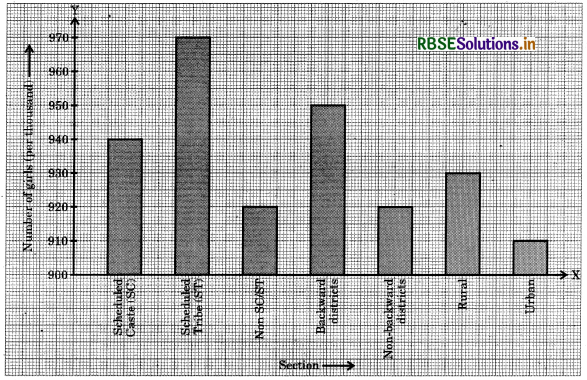
Question 3.
Given below are the seats won by different political parties in the polling outcome of a state assembly elections:

(i) Draw a bar graph to represent the polling results.
(ii) Which political party won the maximum number of seats?
Answer:
In the graph drawn, political parties are denoted along the X-axis and the number of seat won by them along the Y-axis. Scale: 1 cm = 10 seats.
The required graph is as follows:
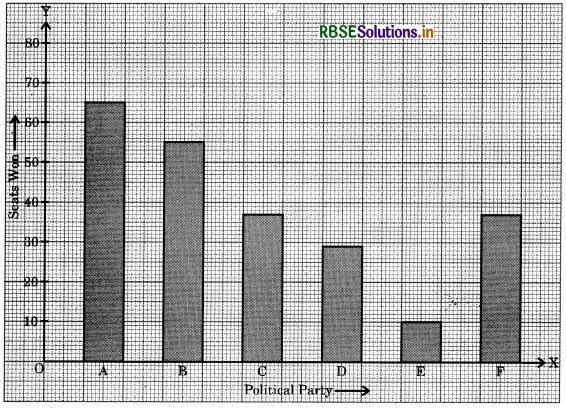
(ii) Party A won the maximum number of seats.

Question 4.
The length of 40 leaves of a plant are measured correct to one millimetre, and the obtained data is represented in the following table:
|
Length (in mm) |
Number of leaves |
|
118 - 126 |
3 |
|
127 - 135 |
5 |
|
136 - 144 |
9 |
|
145 - 153 |
12 |
|
154 - 162 |
5 |
|
163 - 171 |
4 |
|
172 - 180 |
2 |
(i) Draw a histogram to represent the given data. [Hint: First make the class intervals continuous.]
(ii) Is there any other suitable graphical representation for the same data?
(iii) Is it correct to conclude that the maximum number of leaves are 153 mm long? Why?
Answer:
(i) The given frequency distribution is not continuous. So, we shall first convert it into a continuous frequency distribution.
The difference between the lower limit of a class and the upper limit of the preceding class is 1, i.e. h = 1. To convert the given frequency distribution into a continuous frequency distribution, we subtract \(\frac{h}{2}\) = \(\frac{1}{2}\) = 0.5 from each of lower and add 0.5 to each upper limit. The distribution so obtained is given below:
|
Length (in mm) |
Number of leaves |
|
117.5 - 126.5 |
3 |
|
126.5 - 135.5 |
5 |
|
135.5 - 144.5 |
9 |
|
144.5 - 153.5 |
12 |
|
153.5 - 162.5 |
5 |
|
162.5 - 171.5 |
4 |
|
171.5 - 180.5 |
2 |
The histogram of the above frequency distribution is shown as under:
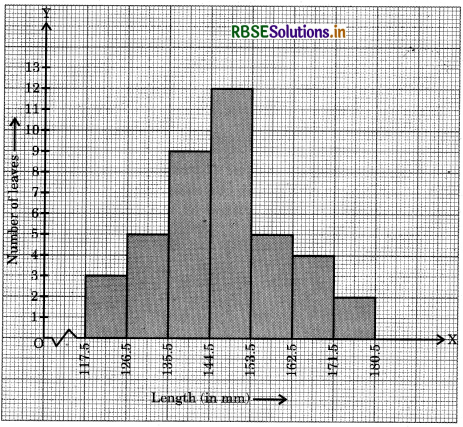
(ii) Frequency polygon is another method of representing this data graphically.
(iii) No. Though in the class interval 145-153, the length of leaves is maximum, but there might be no leave of length 153 mm.

Question 5.
The following table gives the life times of 400 neon lamps:
|
Life time (in hours) |
Number of lamps |
|
300 - 400 |
14 |
|
400 - 500 |
56 |
|
500 - 600 |
60 |
|
600 - 700 |
86 |
|
700 - 800 |
74 |
|
800 - 900 |
62 |
|
900 - 1000 |
48 |
(i) Represent the given information with the help of a histogram.
(ii) How many lamps have a life time of more than 700 hours?
Answer:
(i) The histogram of the given frequency distribution is shown as under :
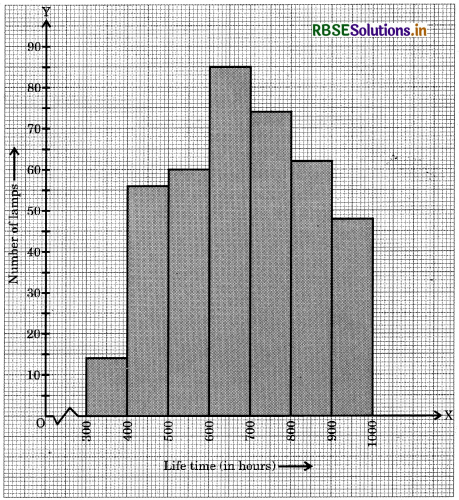
(ii) Number of lamps having life time more than 700 hours = 74 + 62 + 48 = 184.

Question 6.
The following table gives the distribution of students of two sections according to the marks obtained by them:

Represent the marks of the students of both the sections on the same graph by two frequency polygons. From the two polygons compare the performance of the two sections.
Answer:
First we obtain the class marks as given in the following table :

We represent class marks along the X-axis on a suitable scale and the frequencies along the Y-axis on a suitable scale.
To obtain the frequency polygon of Section A, we plot the points (5, 3), (15, 9), (25, 17), (35, 12) and (45, 9) and join these points by line segments.
To obtain the frequency polygon of Section B, we plot the points (5, 5), (15,19), (25, 15), (35, 10) and (45, 1) on the same scale and join these points by dotted line segments.
The two frequency polygons are as shown below:


Question 7.
The runs scored by two teams A and B on the first 60 balls in a cricket match are given below:

Represent the data of both the teams on the same graph by frequency polygons. [Hint : First make the class interval continuous.]
Answer:
First we obtain the class marks as given in the following table:

We represent class marks along X-axis on a suitable scale and frequencies (number of runs) along Y-axis on a suitable scale.
To obtain the frequency polygon of Team A, we plot the points (3.5, 2), (9.5, 1), (15.5, 8), (21.5, 9), (27.5, 4), (33.5, 5), (39.5, 6), (45.5, 10), (51.5, 6) and (57.5, 2) and join these points by the line segments.
To obtain the frequency polygon of Team B, we plot the points (3.5, 5), (9.5, 6), (15.5, 2), (21.5, 10), (27.5, 5), (33.5, 6), (39.5, 3), (45.5, 4), (51.5, 8) and (57.5, 10).
The two frequency polygons are as shown below:
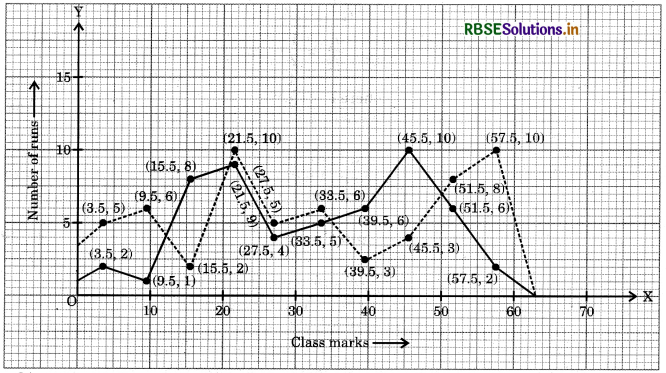

Question 8.
A random survey of the number of children of various age groups playing in a park was found as follows:
|
Age (in years) |
Number of children |
|
1-2 |
5 |
|
2-3 |
3 . |
|
3-5 |
6 |
|
5-7 |
12 |
|
7-10 |
9 |
|
10-15 |
10 |
|
15 - 17 |
4 . |
Draw a histogram to represent the data above.
Answer:
In the given frequency distribution, we see that the class-sizes are different. Hence, we calculate the adjusted frequency for each class by using the formula :
Adjusted frequency for a class = \(\frac{\text { Minimum class-size }}{\text { Class-size of this class }}\) × Its frequency.
In this problem, the minimum class-size = 2 - 1 = 1.
We thus obtain the following table of the adjusted frequency.
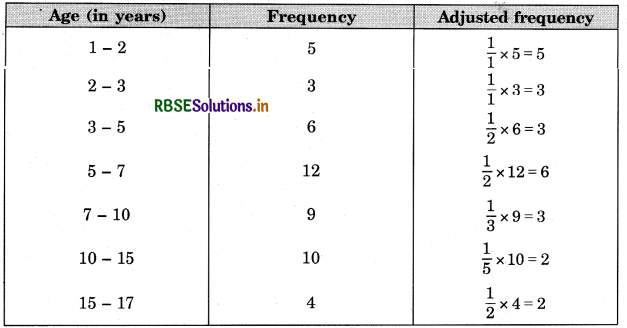
We now represent the class intervals along the X-axis on a suitable scale and the corresponding adjusted frequencies along the Y-axis on a different suitable scale. Now, we draw rectangles with the class intervals as bases and the corresponding adjusted frequencies as the heights. The required histogram is as shown below:
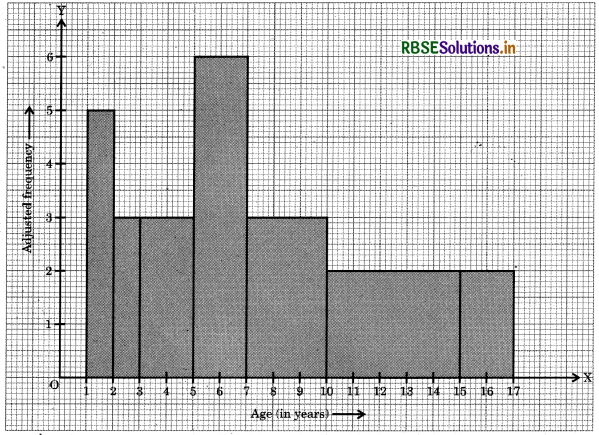

Question 9.
100 surnames were randomly picked up from a local telephone directory and a frequency distribution of the number of letters in the English alphabet in the surnames was found as follows :
|
Number of letters |
Number of surnames |
|
1-4 |
6 |
|
4-6 |
30 |
|
6-8 |
44 |
|
8-12 |
16 |
|
12 - 20 |
4 |
(i) Draw a histogram to depict the given information.
(ii) Write the class interval in which the maximum number of surnames lie.
Answer:
(i) In the given frequency distribution, we see that the dass-sizes are different. Hence, we calculate the adjusted frequency for each dass by using the formula:
Adjusted frequency for a class = \(\frac{\text { Minimum class size }}{\text { Class size of this class }}\) × Its frequency.
In this problem, the minimum class-size = 6 - 4 = 2.
We thus obtain the following table of the adjusted frequencies:
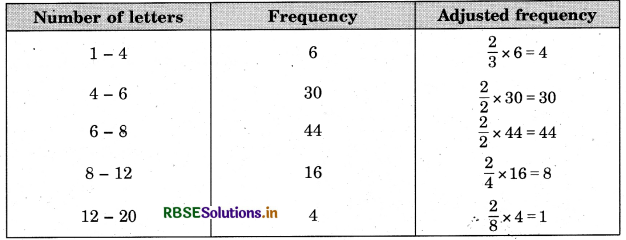

We now represent the class intervals along the X-axis on a suitable scale and the corresponding adjusted frequencies along the Y-axis on a different suitable scale.
Now, we draw rectangles with the class intervals as bases and the corresponding adjusted frequencies as the heights. The required histogram is as shown on the side.
(ii) The maximum of surnames lies in class interval 6 - 8.

- RBSE Solutions for Class 9 Maths Chapter 6 रेखाएँ और कोण Ex 6.3
- RBSE Solutions for Class 9 Maths Chapter 14 सांख्यिकीEx 14.3
- RBSE Solutions for Class 9 Maths Chapter 13 पृष्ठीय क्षेत्रफल एवं आयतन Ex 13.5
- RBSE Solutions for Class 9 Maths Chapter 13 पृष्ठीय क्षेत्रफल एवं आयतन Ex 13.4
- RBSE Solutions for Class 9 Maths Chapter 10 Circles Ex 10.3
- RBSE Solutions for Class 9 Maths Chapter 10 Circles Ex 10.2
- RBSE Solutions for Class 9 Maths Chapter 10 Circles Ex 10.1
- RBSE Solutions for Class 9 Maths Chapter 9 Areas of Parallelograms and Triangles Ex 9.2
- RBSE Solutions for Class 9 Maths Chapter 11 Constructions Ex 11.1
- RBSE Solutions for Class 9 Maths Chapter 9 Areas of Parallelograms and Triangles Ex 9.3
- RBSE Solutions for Class 9 Maths Chapter 11 Constructions Ex 11.2